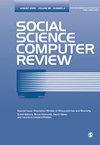青少年瘾君子对基于智能手机的互联网应用的偏好与智能手机成瘾:心理网络中的性别差异
IF 2.7
2区 社会学
Q2 COMPUTER SCIENCE, INTERDISCIPLINARY APPLICATIONS
引用次数: 0
摘要
年轻人是智能手机成瘾(SA)的高风险人群,而智能手机成瘾会带来社会问题。对智能手机网络应用程序的偏好(PSIA)是一个得到理论和实证支持的 SA 近端风险因素。然而,以往的研究大多忽视了 SA 的性别差异和症状异质性。此外,以前的许多数据分析都包含非成瘾者,得出的结果可能不适用于智能手机成瘾者。为了弥补这一缺陷,我们采用症状层面的网络分析方法,评估了高度手机成瘾的年轻人(619 名女性和 415 名男性)对 8 种基于智能手机的互联网应用软件的偏好与 4 种 SA 症状之间的性别差异。结果显示(1) 与男性成瘾者相比,女性成瘾者对视频的偏好与 "失控 "症状之间的关系更为明显。(2)在女性的智能手机应用-SA 网络中,购物应用具有更强的桥中心性,这与更多的 SA 症状呈正相关。(3)我们的研究发现了智能手机成瘾者心理网络中的边缘性别差异,女性成瘾者在社交媒体/电子书偏好和戒断症状之间表现出更强的联系,而男性成瘾者在游戏/电子书和其他智能手机活动之间表现出更强的联系。该研究提供了可视化的网络关联和网络指标,用于理解 PSIA 与戒断症状之间的关系。我们建议采用选择性加工假说和进化心理学视角来帮助理解这些性别差异。本文章由计算机程序翻译,如有差异,请以英文原文为准。
Preference for Smartphone-Based Internet Applications and Smartphone Addiction Among Young Adult Addicts: Gender Difference in Psychological Network
Young adults are a high-risk population for developing smartphone addiction (SA), which bring about social issues. One theoretically and empirically supported proximal risk factor of SA is preference for smartphone-based internet applications (PSIA). However, most previous studies ignore gender difference and symptomatic heterogeneity of SA. Besides, many previous data analyses contain non-addicts, and the results derived might not be applicable to smartphone addicts. To bridging the gap, we used a symptom-level network analysis to assess gender differences in the links between preferences for 8 smartphone-based internet applications and 4 SA symptoms among young adults with high-level phone addiction (619 women and 415 men). The results showed that: (1) The relationship between the preference for video and the “loss of control” symptom was more pronounced in female addicts compared to their male counterparts. (2) Shopping app had stronger bridge centrality in women’s smartphone applications-SA network, which was positively linked with more SA symptoms. (3) Our research identified marginal gender differences in smartphone addicts' psychological networks, with female addicts showing stronger links between social media/eBook preferences and withdrawal symptoms, and male addicts displaying a stronger connection between gaming/eBook and other smartphone activities. The study provides a visualized network association and network metrics for understanding the relationship between PSIA and SA. We propose adopting a selective processing hypothesis and an evolutionary psychology perspective to aid in understanding these gender differences.
求助全文
通过发布文献求助,成功后即可免费获取论文全文。
去求助
来源期刊

Social Science Computer Review
社会科学-计算机:跨学科应用
CiteScore
9.00
自引率
4.90%
发文量
95
审稿时长
>12 weeks
期刊介绍:
Unique Scope Social Science Computer Review is an interdisciplinary journal covering social science instructional and research applications of computing, as well as societal impacts of informational technology. Topics included: artificial intelligence, business, computational social science theory, computer-assisted survey research, computer-based qualitative analysis, computer simulation, economic modeling, electronic modeling, electronic publishing, geographic information systems, instrumentation and research tools, public administration, social impacts of computing and telecommunications, software evaluation, world-wide web resources for social scientists. Interdisciplinary Nature Because the Uses and impacts of computing are interdisciplinary, so is Social Science Computer Review. The journal is of direct relevance to scholars and scientists in a wide variety of disciplines. In its pages you''ll find work in the following areas: sociology, anthropology, political science, economics, psychology, computer literacy, computer applications, and methodology.
 求助内容:
求助内容: 应助结果提醒方式:
应助结果提醒方式:


